by Larry Williams | May 11, 2017
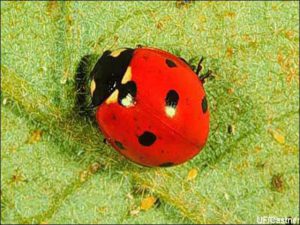
Adult Ladybug. Photo Credit: James Castner University of Florida
A number of summers ago, I noticed whiteflies on a confederate rose plant in my landscape. I considered using an insecticide to control the whiteflies but decided against doing so after taking a closer look. What I found was a population of ladybugs – eggs, larvae, pupae and adults.
Ladybug adults and larvae eat whiteflies, as well as other soft-bodied insects such as aphids. So, I waited to see what would happen.
At first I was seeing mostly adult whiteflies, which look like tiny white moths. Adult whiteflies mate and then lay eggs on the underside of leaves. The eggs hatch into flat translucent scale-like nymphs that suck the “juice” from the underside of the leaves.
Eventually, some of the leaves developed a black coating called sooty mold. As certain insects (primarily aphids, some scales and whiteflies) feed, they excrete plant sap that coats the leaves. Sooty mold then grows on this sugary sap. It’s not a pathogen. It just makes the leaves look ugly.
Knowing that the whiteflies would not kill the confederate rose, I was willing to tolerate the sooty mold and allow the ladybug population to build.
Allowing whiteflies to live on your plants may not always be the best option. But in order to have beneficial insects in your landscape, there must be some “bad” insects for them to eat.
Insects such as ladybugs, lacewings and praying mantises eat many pest insects. Encouraging these beneficial insects can allow you to reduce the amount of pesticides applied.
It’s important to learn to recognize the adult and immature stages of these beneficial insects. Ladybugs have larvae that look nothing like
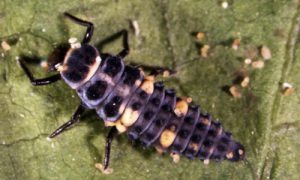
Ladybug larva. Photo credit: Aristizabal University of Florida
the adults. Some ladybug larvae look like small orange and black alligators. Others may resemble mealybugs. Many gardeners that would never kill adult ladybugs mistake their larvae as pests and kill them with insecticides.
The following UF/IFAS Extension website will help you learn to recognize many of our beneficial insects. http://edis.ifas.ufl.edu/topic_beneficial_insects
Once you find beneficial insects in your landscape, reduce or eliminate the use of insecticides. When an insecticide is needed, use environmentally friendly options such as insecticidal soaps, horticultural oils and products that contain Bacillus thuringiensis (Bt).
Sometimes a heavy stream of water from a water hose is all that is needed to remove pest insects from plants and reduce their numbers to an acceptable population.
Remember, leaving a few pest insects is a great way to attract beneficial insects. Tolerating a minor infestation and a little plant damage will benefit the helpful insects, your pocketbook and the environment.
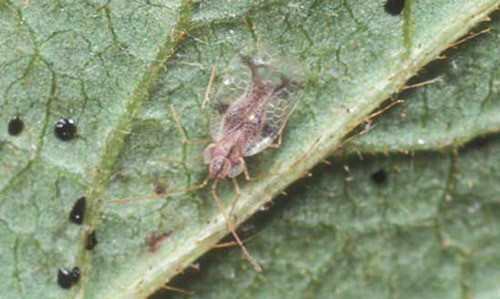
by Sheila Dunning | Mar 20, 2017
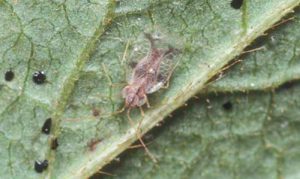 Now is the time to prevent your azaleas from being attacked by lace bugs. The azalea lace bug, Stephanitis pyrioides, overwinters as eggs on the underside of infested leaves. Eggs hatch in late March and early April. The insect then passes through five nymphal instars before becoming an adult. It takes approximately one month for the insect to complete development from egg to adult and there are at least four generations per year. Valuable plants that are susceptible to lace bug damage should be inspected in the early spring for the presence of overwintering lace bug adults, eggs and newly hatched nymphs. Inspect these plants every two weeks during the growing season for developing lace bug infestations.
Now is the time to prevent your azaleas from being attacked by lace bugs. The azalea lace bug, Stephanitis pyrioides, overwinters as eggs on the underside of infested leaves. Eggs hatch in late March and early April. The insect then passes through five nymphal instars before becoming an adult. It takes approximately one month for the insect to complete development from egg to adult and there are at least four generations per year. Valuable plants that are susceptible to lace bug damage should be inspected in the early spring for the presence of overwintering lace bug adults, eggs and newly hatched nymphs. Inspect these plants every two weeks during the growing season for developing lace bug infestations.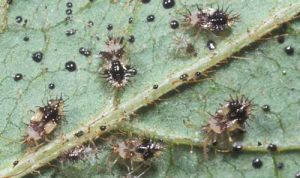
Both adults and nymphs have piercing-sucking mouthparts and remove sap as they feed from the underside of the leaf. Lace bug damage to the foliage detracts greatly from the plants’ beauty, reduces the plants’ ability to produce food, decreases plant vigor and causes the plant to be more susceptible to damage by other insects, diseases or unfavorable weather conditions. The azalea can become almost silver or bleached in appearance from the feeding lace bug damage.
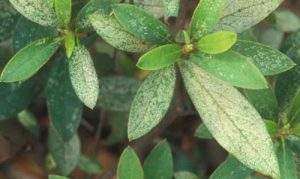 However, lace bugs often go undetected until the infested plants show severe damage sometime into the summer. By then several generations of lace bugs have been weakening the plant. Inspecting early in the spring and simply washing them off the underside of the leaves can help to avoid damage later and the need for pesticides.
However, lace bugs often go undetected until the infested plants show severe damage sometime into the summer. By then several generations of lace bugs have been weakening the plant. Inspecting early in the spring and simply washing them off the underside of the leaves can help to avoid damage later and the need for pesticides.
Adult lace bugs are flattened and rectangular in shape measuring 1/8 to 1/4 inch long. The area behind the head and the wing covers form a broadened, lace-like body covering. The wings are light amber to transparent in color. Lace bugs leave behind spiny black spots of frass (excrement).
Lace bug nymphs are flat and oval in shape with spines projecting from their bodies in all directions. A lace bug nymph goes through five growth stages (instars) before becoming an adult. At each stage the nymph sheds its skin (molts) and these old skins often remain attached to the lower surface of infested leaves.
Azalea lace bug eggs are football-shaped and are transparent to cream-colored. Lace bug eggs are found on the lower leaf surface, usually alongside or inserted into a leaf vein. Adult females secrete a varnish-like substance over the eggs that hardens into a scab-like protective covering.
For more information go to: http://entomology.ifas.ufl.edu/creatures/orn/shrubs/azalea_lace_bug.htm

by Sheila Dunning | Feb 3, 2017
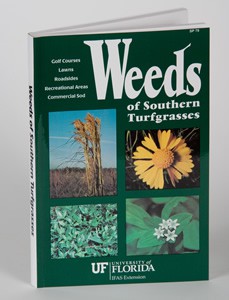 Remember last summer? The hot, dry days. Grass drying up and turning brown. Yet, the weeds are green and doing fine. However, every herbicide label warns against applying when the temperatures are above 85 degrees and especially under drought conditions. Those weeds flourished and dispersed seed everywhere. Now, they are just sitting there ready to sprout again.
Remember last summer? The hot, dry days. Grass drying up and turning brown. Yet, the weeds are green and doing fine. However, every herbicide label warns against applying when the temperatures are above 85 degrees and especially under drought conditions. Those weeds flourished and dispersed seed everywhere. Now, they are just sitting there ready to sprout again.
It’s time to start thinking about weed prevention. Pre-emergent herbicides need to be applied prior to seed germination. Late winter is the time to focus on summer annual weeds. The narrow window of application is challenging. Homeowners often wait too late into spring to put out preventative products. A general rule of thumb for pre-emergent herbicide timing is February 15 – March 1 in North Florida.
However, weed seeds germinate in response to soil temperature, not calendar dates. By monitoring day time temperatures, one can determine a more effective application date. When there are 4-5 consecutive days that reach 65 to 70 degrees weeds will germinate. This generally coincides with the first blooms appearing on azaleas and dogwood. With a warm winter it may occur as early as mid-January.
Some of the active ingredients in pre-emergent herbicides include dithiopyr, isoxaben, oryzalin, pendimethalin, prodiamine and simazine. Always read the label for specific weed controlled and observe all directions, restrictions and precautions.
Weed and feed products that contain nitrogen are not suitable as pre-emergent herbicides. Irrigation before and after application is necessary to activate these products. The chemical binds to soil particles, creating a barrier that remains effective for 6-12 weeks. Reapplication will be necessary for season long control, especially with constantly fluctuating winter temperatures. Now is the time to purchase pre-emergent herbicides and prepare to apply them. For more information on weed control in lawns go to: http://edis.ifas.ufl.edu/ep141
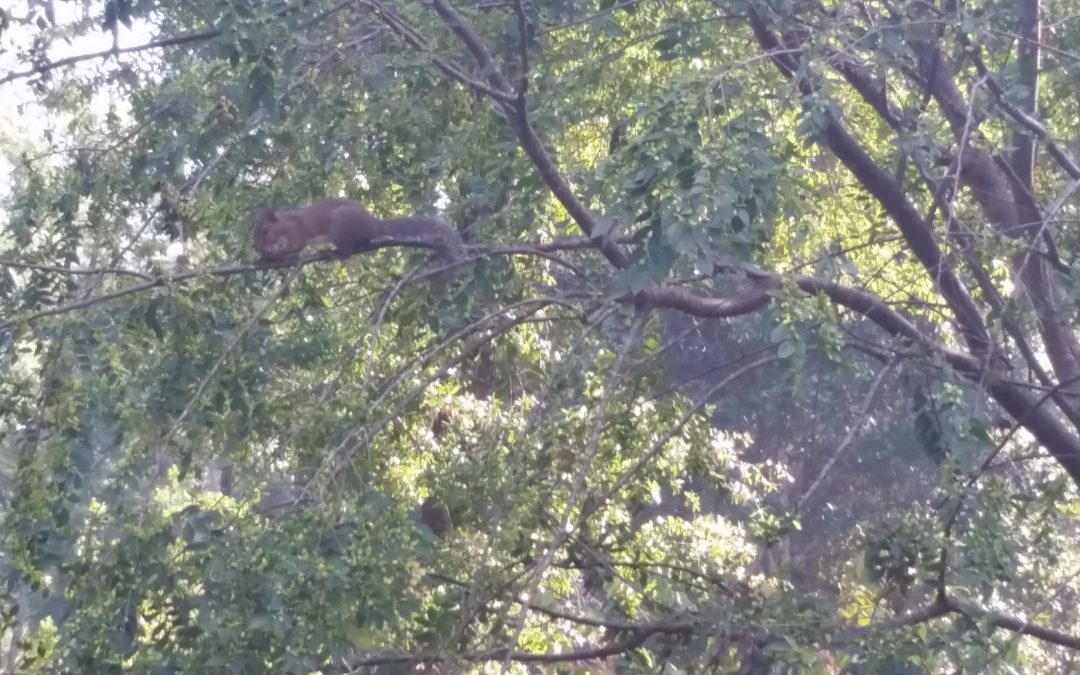
by Matt Lollar | Nov 7, 2016

Chinese elm tree leaves fall due to feeding squirrels. Photo Credit: University of Florida/IFAS Extension
The Chinese elms in my yard are under attack. They are dropping leaves and the temperature’s still in the 70s. Upon closer look, they aren’t just dropping leaves but the tips of branches too. What is going on? Is there a new insect pest wreaking havoc on my trees? Did I do something wrong? No, no, and…no. The culprits are tree rats! You know, those bushy-tailed rodents that live in the trees (also known as squirrels).
Squirrels feed on a number of things in my yard including mushrooms, acorns, and now I’ll have to add elm branches to the list. Chewing on branches doesn’t sound appetizing to me but, as with everything, there is a reason for it. The best explanation is that the varmints can sense an accumulation of sugars in the trees and they are feeding on the cambium layer underneath the bark.
Another explanation is that there are no other preferred food sources available. However, I can debunk that theory because the squirrels have not even touched my ripe satsumas. And we all know that satsumas taste a lot better than tree branches.
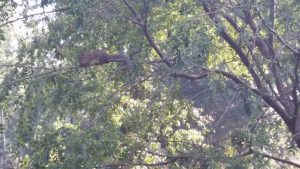
A hungry squirrel feeds on Chinese elm wood. Photo Credit: University of Florida/IFAS Extension.
Whatever the reason, the feeding may actually do a bit of good for the trees. The squirrels mainly feed on the new tree growth. This helps to promote new branching, growth which will potentially contribute to better shading from the tree. However, there is a tried-and-true solution to the problem if the squirrels annoy you as much as they annoy me. I prefer to brine squirrel in a mixture of water, salt, and sugar before I put them on the grill but you can prepare them in any way you’d like.

by Beth Bolles | Oct 7, 2016
The year’s mild winter and frequent rain showers have created lush lawns and gardens with an abundance of insects. As a result, we are seeing many predator arthropods taking advantage of the available feast. One of the morning interesting creatures in the garden is the spiny orb weaver spider (Gasteracantha cancriformis) that has an interesting body shape.
Spiny orb weavers are common spiders in landscapes that might not be noticed since they are much smaller than the Yellow garden spider (Argiope aurantia) and the Golden silk spider (Nephila clavipes). Once viewed, the spiny orb weaver will catch your attention because it’s abdomen has six ‘spines’ or points that extend out. Spiders also have a mix of yellow, white, red, or black marking on the abdomen.
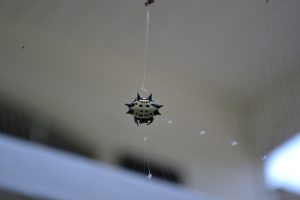
Spiny orb weaver in the center of the web waiting for a meal. Photo by Beth Bolles
Although spiders are small, the webs which are common amongst shrubs, trees, and edges of woods become quite substantial in the fall. There may be up to 30 spirals that extend out with the spider situated in the center. You may unexpectedly encounter a web when walking through the garden or mowing around trees and shrubs. There is no worry if a spider accidently gets on you as bites are not common and not considered serious.
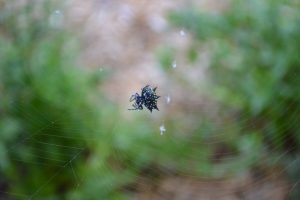
Spider working on her web. Photo by Beth Bolles
Some may refer to the spiny orb weaver as a crab spider based on its shape, but it is a web building where the true crab spiders are active hunters often found resting on flowers in order to ambush a meal.
Enjoy our fall weather and look out for this beneficial spider in your landscape.
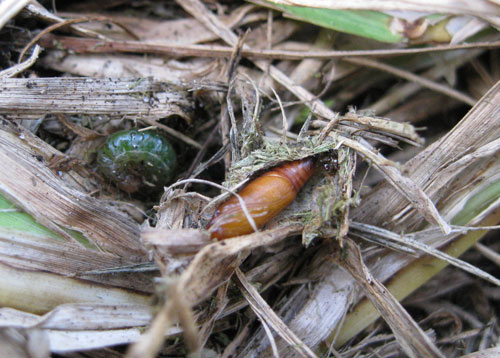
by Matt Lollar | Sep 29, 2016
Tropical sod webworms (Herpetogramma phaeopteralis) have recently been encountered in a number of yards in the Panhandle. The worms usually feed in large groups and unfortunately, the first, and basically the only, sign of damage is often a large area of shorter grass due to their feeding. The arrival time of sod webworms is also unfortunate because they are part of a group of caterpillars that successively attack turf including fall armyworm (Spodoptera frugiperda), striped grass loopers (Mocisspp.), and the fiery skipper (Hylephila phyleus).
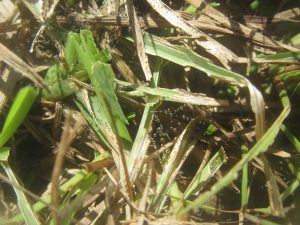
Sod webworm feeding damage in the turf thatch layer. Photo Credit: University of Florida/IFAS Extension.
Description
Larvae
Caterpillars are light yellow to orange with brown spots on each body segment and they have a dark, orange-brown head. They will grow to a full length of slight less than 1/2 inch.
Pupae
The reddish brown pupae are about about 1/4 inch long. The pupae are typically found in the upper thatch layer.

Pupa found in cocoon in St. Augustinegrass thatch. Photo Credit: Steven Arthurs, University of Florida/IFAS
Adults
The moths brown with splotchy wings and are about 3/4 inch wide.
Control
Sod webworms are difficult to control because of their spontaneity. However, in the lawn they hide in the thatch during the heat of the day. Over watering and fertilization can increase the amount of thatch. It is important to follow UF/IFAS guidelines for home lawn management.
The first line of defence is healthy turf. Proper fertilization, irrigation, and mowing height can decrease susceptibility of turfgrass against sod webworm. Over-fertilization is a common cause of caterpillar outbreaks in lawns. Cultural practices such as thatch removal by vertical mowing can help eliminate populations. Eggs are laid on grass blades and removal of grass clippings might also reduce populations.
Numerous chemical control options are available, but softer chemicals such as insecticides containing the bacteria Bacillus thuringiensis are recommended as a first line of defense. Insecticides should be applied in the morning or evening during feeding time. For additional control strategies and basic information please visit the UF/IFAS Sod Webworm Publication.

















